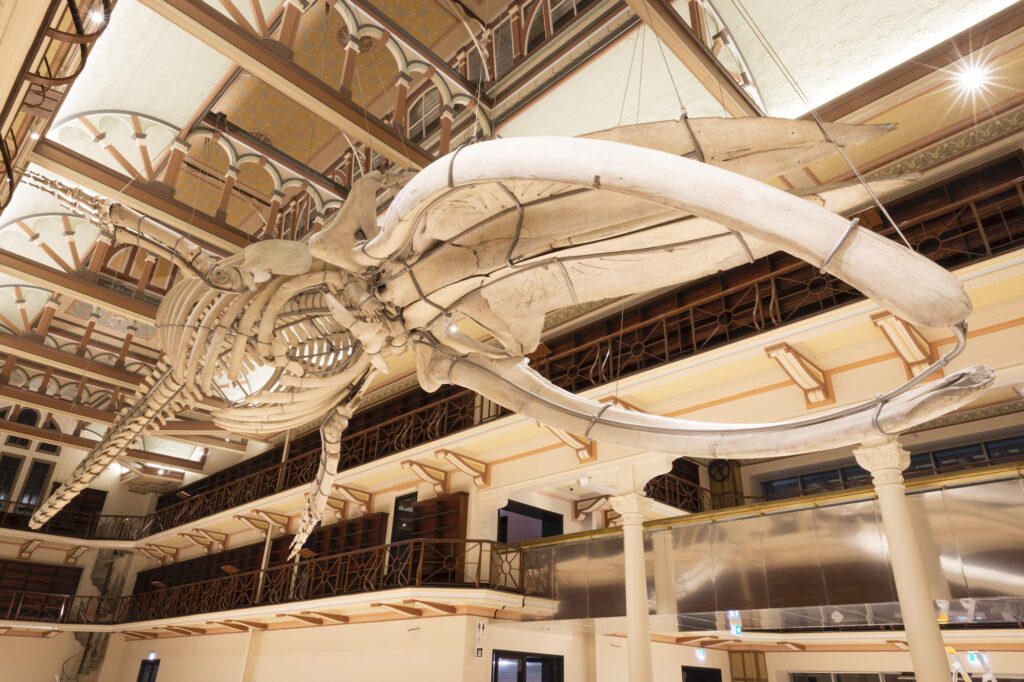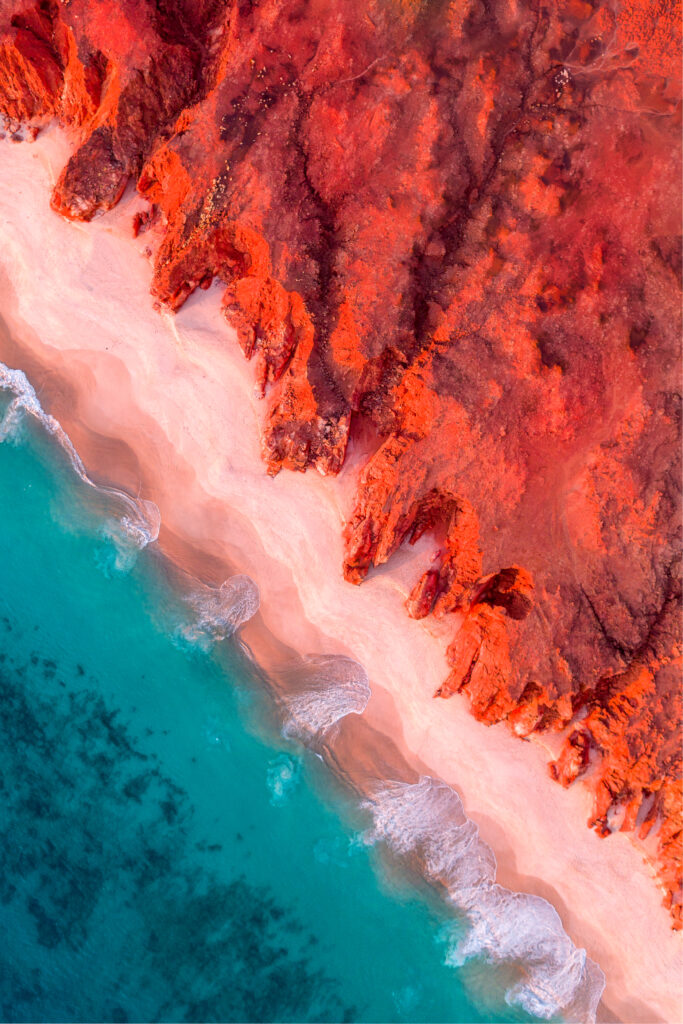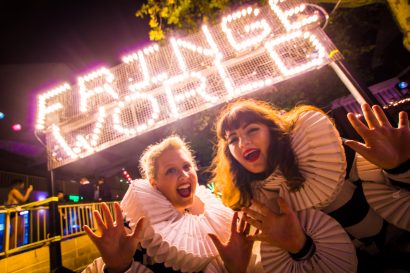The WA Museum Boola Bardip has become a architectural landmark, but how has it fared in its first year and what is the curatorial vision? Rania Ghandour checks in on the state-of-the-art museum and its 2022 program.
2022 program illuminates the future of new museum
10 December 2021
- Reading time • 10 minutesMulti-arts
More like this
- Halloween special: How to make blood and other stage tricks
- Seadragon weaves magic spell
- Spring into the school holidays
During a visit to the WA Museum Boola Bardip on the first anniversary of its opening, I was surprised to meet one of the exhibits out for a walk. Bob, the bobtail lizard was outside in the gardens enjoying the sunshine when I arrived to meet Alec Coles, the museum’s chief executive officer.
“We have a few live animals, but it’s limited to things we can care for responsibly,” Coles says, telling me how the museum found Bob in a poor state and nursed him back to health.
After this surprising start to the visit, the conversation turns to how Boola Bardip has fared in its first year and what the purpose of a modern museum might be.
“If we think about what the unique selling point of a museum is, I think it’s authenticity, because we’ve got real things, real stories told by real people,” Coles says. “And those things can sometimes be incredible things like a blue whale skeleton, or a massive meteorite, or they can be quite unprepossessing things that have incredible stories behind them.”
Many Western Australians remember these iconic objects from the old museum, and after waiting several years for the new Museum to be built, we’ve have had it pretty much to ourselves during the first year of operations.

While border restrictions kept WA relatively free from community transmission of COVID-19, Coles says it has affected visitor numbers. Normally interstate visitors would make up around 40% of the museum’s visitors. From July to September 98% of visits to WA Museum Boola Bardip were made by those within Australia, and of those, 98% were by WA locals. During this period repeat visitors accounted for a quarter of visits.
Despite several closures during lockdowns visitation has been above target, with 700,000 visitors coming through the museum in its first 12 months.
The way visitors have interacted with the building itself has also been affected by COVID-19 restrictions. The award-winning architectural design was intended to create a very permeable site.
“We always felt that you didn’t have to go through some edifice; the idea was to just be able to drift in if you wanted to. But obviously with COVID we had to control the way people came in,” Coles says.
This included restricted visitor numbers at times or stopping people at the entrance to sign in for contact tracing.
Exhibitions were also impacted. Some had to be rescheduled and others, such as the popular Songlines from the National Museum of Australia, or the British Museum’s Ancient Greeks, have presented logistical challenges, with early closures and installations and deinstallations being done remotely, guided by museum colleagues on the opposite side of the country or the world.
Despite these challenges, Coles says the museum looks forward to Boola Bardip’s second year and hopefully welcoming visitors from further afield.
2022 program tells West Australian stories

The museum’s 2022 program was announced today with four world premier experiences opening on Saturday 11 December and running until the end of January.
The program includes Nyumbi, weekly dance and song performances by Nyoongar dancers; Virtual Realms, an immersive exhibition from London’s Barbican; Dinosaurs of Patagonia, a chance to walk with the largest dinosaurs that ever roamed the Earth, designed by Argentina’s Museo Paleontológico Egidio Feruglio (MEF); and Wonderland, an exhibition celebrating the timeless stories of Lewis Carroll, developed by the Australian Centre for Moving Image (ACMI).
But, for the summer ahead, the four exhibitions opening tomorrow offer a sumptuous look at WA’s art, landscapes and people. Each night from sunset visitors can enjoy Illuminate: Timescapes, digital projections on Boola Bardip’s Old Gaol, inspired by the Museum’s collections and WA’s natural beauty.
A spectacular 360-degree virtual reality (VR) film Beyond the Milky Way centres on one of the biggest scientific endeavours in human history, the construction of the world’s largest radio telescopes, currently under construction in WA’s midwest. Directed by WA talent Breige Whitehead (behind the award-winning VR film The Antarctica Experience) and narrated by physicist Professor Brian Cox, the film takes viewers deep into space to explore the formation of the universe.
The multimedia installation Walking with Colour: Cinematic Nature by Perth-based videographer, photographer and cinematographer Michael Haluwana is another highlight.
“He’s a phenomenon and works a lot with David Attenborough,” Coles says.
The installation promises a “journey through vibrant projections and mesmerising multimedia installations that showcase Western Australia’s landscapes and seascapes in incredible detail”.
Connection to country
Belong: Language connecting feeling, culture, country by Martine Perret highlights the link between First Nations Elders, language speakers and the land, and emphasises the cultural importance of languages.
“[Perret] used to be a war-zone photographer with the UN,” Coles says. “In this exhibition, she’s worked with Aboriginal communities across WA. It’s their voices featured; they’re all Aboriginal stories.”
Nyoongar Elder Irene Stainton says it’s important to have these voices in the Museum. Stainton is the chair of the WA Museum’s Aboriginal Advisory Committee and has been in this role since the Committee started 26 years ago.
The Aboriginal Advisory Committee has representatives from the regions and is consulted on exhibition content.
“When it’s Aboriginal content we advise them of our support to ensure cultural appropriateness,” Stainton says.
“We’re talking about content for a State museum so it’s important that we have people who can talk about the content through their connections to Country. It’s really important that we have people at the table that represent those regions to get the attitudes and the views from a regional perspective. It’s important to have content from everyday people who are still living the lives back in community that you don’t really get if you’re looking at objects and relics,” she says.
Stainton believes it is essential to have this human approach to cultural content and what it means to people today.
“When you look at cultural material and the associated stories, they remain equally as important today as they were in the past,” she says.
A trusted place
The power of objects to hold stories touches on the question of ownership of objects and ongoing debate on whether museums should give back or repatriate objects that have been pillaged, stolen or simply taken from elsewhere, the most famous example of which is the Elgin Marbles in the British Museum.
Coles believes sometimes things are not so clear cut, but other times they are.
“On the one hand, if you give everything back to everybody, how are we ever going to learn about each other? But if we stole stuff, then absolutely we should give it back.”
Coles believes museums are exactly the right place to discuss these kinds of ideas. They are “safe spaces for unsafe ideas,” he says, quoting international museum consultant Elaine Heumann Gurian.
Museums are trusted places, which is why the choices they make can shape the narratives and stories we tell about ourselves.
By way of example, Coles mentions the way we talk about first contact between Aboriginal and Torres Strait Islander peoples with Europeans. “This is described by some people as settlement, some people as colonisation and other people as invasion,” he says.
Ultimately, a museum is a place that helps people understand their place in the world and each other.
“It’s not a place of social engineering and it’s not a place of campaigning but it should be a place where you can have difficult conversations and where you can be trusted to deal with that responsibly,” he says. “And of course, hopefully it’s an exciting place to be.”
As I farewell Alec, Bob the bobtail and other treasures great and small in the museum, I’m already planning my next visits over the summer and beyond.
For information about WA Museum Boola Bardip’s exhibitions and experiences head to visit.museum.wa.gov.au/boolabardip
Pictured top: Each night until the end of January visitors can enjoy the digital projections from “Illuminate: Timescapes“, on the walls of Boola Bardip’s Old Gaol. Photo: Alison Rodrigues
Like what you're reading? Support Seesaw.






